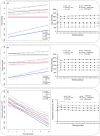The impact of pandemic-related social distancing regulations on exercise performance-Objective data and training recommendations to mitigate losses in physical fitness
- PMID: 36926166
- PMCID: PMC10011707
- DOI: 10.3389/fpubh.2023.1099392
The impact of pandemic-related social distancing regulations on exercise performance-Objective data and training recommendations to mitigate losses in physical fitness
Abstract
Introduction: In the context of the COVID-19 pandemic in Germany, governmental restrictions led to the closure of sports facilities for several months. To date, only subjective and fitness-tracking related data on physical activity during the pandemic are available. Using data of a chip-controlled fitness circuit, training data as a measure of physical performance before and after the lockdown during the first wave of the COVID-19 pandemic will show the impact of the training interruption on exercise performance in middle-aged and older adults. The re-training data are analyzed, to extract practical recommendations.
Methods: Objective training data of 17,450 participants [11,097 middle-aged (45-64 yrs), 6,353 older (≥65 yrs)] were exported from chip-controlled milon® fitness circuit systems before and after the first COVID-19 related lockdown in Germany. The change in the product of training weight (sum of lifting and lowering the training weight) and repetitions on the leg extension resistance exercise device (leg score) between the last three training sessions before the lockdown and the first ten training sessions after individual training resumption as well as the last training session before the second lockdown in October 2020 was analyzed.
Results: Participants who trained with high intensity before the lockdown, experienced deleterious effects of the training interruption (middle-aged group: -218 kg, older group: ~-230.8 kg; p < 0.001 for change in leg score from to post-lockdown) with no age effect. Participants training with a leg score of more than 3,000 kg did not resume their leg score until the second lockdown.
Conclusion: The interruption of training in a fitness circuit with combined resistance and endurance training due to the lockdown affected mainly those participants who trained at high intensity. Apparently, high-intensity training could not be compensated by home-based training or outdoor activities. Concepts for high-intensity resistance training during closure of sports facilities are needed to be prepared for future periods of high incidence rates of infectious diseases, while especially vulnerable people feel uncomfortable to visit sports facilities.
Trial registration: Identifier, DRKS00022433.
Keywords: COVID-19 pandemic; aged; exercise training; health promotion; physical activity; physical fitness; social distancing.
Copyright © 2023 Zieschang, Otto-Sobotka, Shakoor, Lau, Hackbarth and Koschate.
Conflict of interest statement
The authors declare that the research was conducted in the absence of any commercial or financial relationships that could be construed as a potential conflict of interest.
Figures


References
-
- Bundesländer . RKI COVID-19 Germany. (2022). Available online at: https://experience.arcgis.com/experience/478220a4c454480e823b17327b2bf1d... (accessed January 30, 2023).
-
- Musa S, Dergaa I, Tayebi SM. Emergence of SARS-CoV-2 B.1.1.7 and the future of mega sport events: is this the tipping point from pandemic to endemic? Ann Appl Sport Sci. (2022) 10. 10.52547/aassjournal.1114 - DOI
Publication types
MeSH terms
Associated data
LinkOut - more resources
Full Text Sources
Medical

